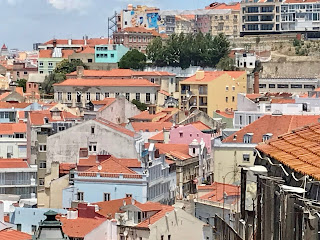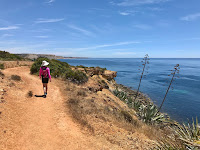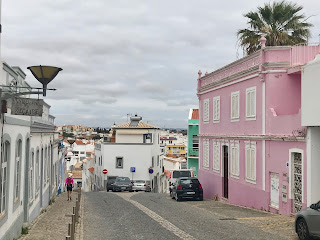1 July
 Left ‘Turisocampo’ near Lagos in the Algarve and headed to the west coast following the inland road. Rolling hills covered in pine trees and as we got closer to the coast, charming white washed villages. Through Aljezur with its Fort and Odeceixe with its windmill.
Left ‘Turisocampo’ near Lagos in the Algarve and headed to the west coast following the inland road. Rolling hills covered in pine trees and as we got closer to the coast, charming white washed villages. Through Aljezur with its Fort and Odeceixe with its windmill.
Onto the coast and ‘Camping Villa Park Zambujeira’ (15 euros). Swimming pool and walking distance from the small historic town of Zambujeira.
Zambujeira is on the Alentejo Coast set in the Coast Vicentina and Sudoeste Alentejano Park.
Walked into the small traditional seaside town perched on top of the steep cliffs which overlook the beach. A huddle of white washed walls and terracotta roofs. Followed the clifftop path to the top of the northern end with its little chapel for a beautiful panorama. Took the coastal cliff top walk for another stunning vista of the coastline. Back down to the beach and swims, the water is much warmer. There is a lifeguard on duty and the locals are enjoying the sun. Zambujeira is also a popular surf beach and attracts many travelling surfers in the summer.
2 July
Walked the clifftop path at the southern end of the town, down the stairs to a beautiful sandy bay. Had a fabulous afternoon swimming and enjoying the sun.
We love the non touristy casual vibe here and the beaches are truly stunning!
3 July
Another great day swimming and enjoying the sun in the sandy bay at the southern end of town.
Sampled the ‘mobile grilled chicken man's' chicken dinner with traditional black bean and bacon salad. Very tasty!
4 July
 Left our fab spot in Zambujeira and headed up the coast through the eucalyptus trees and farmlands via Vila Nova de Milfontes beach alongside the Rio Mira. Portugal is the fourth largest European producer of pulp for paper.
Left our fab spot in Zambujeira and headed up the coast through the eucalyptus trees and farmlands via Vila Nova de Milfontes beach alongside the Rio Mira. Portugal is the fourth largest European producer of pulp for paper.
Through Cereal, Ermides and Canhestros and into agricultural farming dotted with sunflowers interspersed with cork oaks. Passed workers tending the melons and traditional little towns.
Alvito with its castle and into Evora and ‘Camping Orbitur' (26.10 euros) with swimming pool, restaurant and good basic facilities.

 Walked into the fortified medieval town dominated by its Gothic Cathedral begun in the twelfth century surrounded by white washed houses. Through the narrow alleyways and into the picturesque town square where we had a drink overlooking the best preserved temple in Portugal, the Temple of Diana.
Walked into the fortified medieval town dominated by its Gothic Cathedral begun in the twelfth century surrounded by white washed houses. Through the narrow alleyways and into the picturesque town square where we had a drink overlooking the best preserved temple in Portugal, the Temple of Diana. 
 Evidently the Temple was used as a slaughter house until 1870. Took in the elaborate churches and monuments dating from the fourteenth to sixteenth century.
Evidently the Temple was used as a slaughter house until 1870. Took in the elaborate churches and monuments dating from the fourteenth to sixteenth century.
Discovered a lively university town outside of the historic town with quirky eateries and traditional restaurants.
Spent the late afternoon around the pool.
5 July
 Walked to the Evora train station and caught the early train into Lisbon (44 euros for two return). Had to take the metro from the train station to the old town. Climbed the cobbled streets of bohemian Barrio Alto where the Bica Funicular normally runs, passed the lavish São Roque Church to the Garden Terrace for a great view. Lucky for us, Lisbon is built on a series of hills and has many scenic vistas.
Walked to the Evora train station and caught the early train into Lisbon (44 euros for two return). Had to take the metro from the train station to the old town. Climbed the cobbled streets of bohemian Barrio Alto where the Bica Funicular normally runs, passed the lavish São Roque Church to the Garden Terrace for a great view. Lucky for us, Lisbon is built on a series of hills and has many scenic vistas.  Strolled the narrow cobbled streets with its centuries old houses, loved the vivid street art and quirky bars and eateries. Listened to a busker’s fado music in one of the squares.
Strolled the narrow cobbled streets with its centuries old houses, loved the vivid street art and quirky bars and eateries. Listened to a busker’s fado music in one of the squares. Strolled along the Port area to the markets, passed a viewing elevator, through the eatery lined squares, one with two exceptional musicians, violinist and violist playing Coldplay.
Strolled along the Port area to the markets, passed a viewing elevator, through the eatery lined squares, one with two exceptional musicians, violinist and violist playing Coldplay.
Onward to the Castle of São Jorge with its small walled town, for spectacular views including the old city’s pastel-coloured buildings. Through the streets with funiculars and passed by charming vintage trams. Ancient ruins and white domed cathedrals. A vibrant and charismatic capital of Portugal!
Lisbon is Europe’s second oldest capital (after Athens) and once home to the world’s greatest explorers like Vasco da Gama, Magellan and Prince Henry the Navigator becoming the first true world city, the capital of an empire spreading over all continents.
A fabulous day, ‘walked our feet off’! Caught the evening train back to Evora where we enjoyed a fish dinner in one of the alfresco eateries.
Crossing back into Spain tomorrow.
We've had a wonderful stay in Portugal, lovely laid back people, amazing scenery, yummy food, fantastic weather and cost effective.




















































































